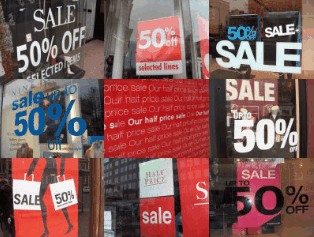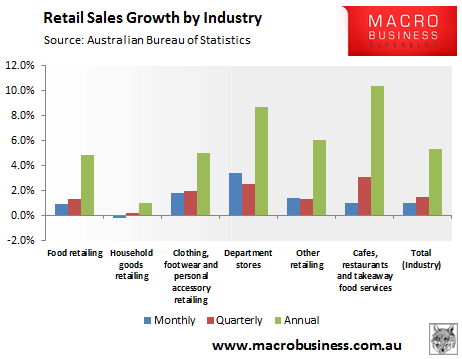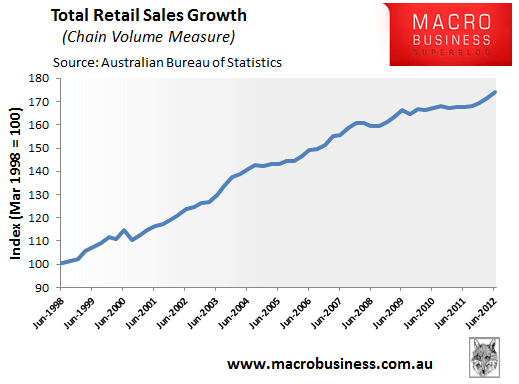
The contradictory signs coming out of the retail sector have continued, with last week’s release of strong retail trade data by the Australian Bureau of Statistics (ABS) contradicted by reports of falling profitability and sales amongst Australia’s large retailers.
Last week’s ABS figures revealed that retail sales grew by 1.0% over the month of June after rising by 0.8% in May, buoyed by recent interest rate cuts along with $2.85 billion of government hand-outs provided to families in May and June as compensation for the new carbon tax.
Gains were broad-based too, with all segments except household goods retailing experiencing solid sales growth (see below chart).

With part of the bounce in sales driven by one-off compensation payments, it is uncertain whether this sales growth can be maintained. Nevertheless, the jump in sales was important as it broke a two-and-a-half year period where the retail sector experienced no inflation-adjusted growth in sales (see below chart).

Yet Australia’s large retailers still appear to be feeling the pinch, with some of Austalia’s largest retailers warning of slumping sales and profitability:
THE furniture and electricals store Harvey Norman has sounded an ominous warning to investors on the eve of the corporate reporting season, revealing yesterday that woeful sales through much of 2012 would strip away as much as 40 per cent of its profits for the full year…
Woolworths and Coles – both with large exposures to the discretionary end of the retail sector via their respective clothes, merchandise and housewares businesses – have warned of little change to sombre consumer behaviour other than a slight, but momentary, pick-up in sales thanks to the federal government’s recent compensation for for the introduction of the carbon tax…
Releasing its fourth-quarter and full-year sales, Harvey Norman said sales for the 2011-12 financial year totalled $5.74 billion, a fall of 7 per cent. After stripping out the impact of new store openings, sales were down 6.5 per cent.
Its comparable store sales growth in the flagship Australian network of shops has worsened through the year, going from negative 2.8 per cent in the first quarter, minus 9.5 per cent in the second quarter, down 7.7 per cent in the third quarter and 7.3 per cent weaker in the fourth quarter…
Meanwhile, over at the AFR, Gerry Harvey has taken to biting the hand that feeds him, criticising the Government’s stimulus payments to households as if they are responsible for the sector’s woes:
Mr Harvey criticised the government’s stimulus spending, saying the cash handouts three years ago had “stalled the inevitable”. While the latest household handouts had given all retailers a boost in June, including Harvey Norman, they would not fix the sector’s problems.
“You have to decide whether giving money away is a way of solving anything. If it’s a short-term fix it doesn’t solve anything,” he said…
“You have had more retailers going broke in the last year or two than you have ever seen before in Australia.
“Many are going broke and it’s not as if we’ve reached the end by a long shot – there’s a long way to go.”
So, on the one hand, you have retail sales growing solidly – albeit after years of flat inflation-adjusted growth and driven in part by one-off stimulus payments. Yet, on the other hand, Australia’s retailers are struggling from falling sales and reduced profitability. Why the contradiction?
Evans and Partners argue that it’s the shift to online retailing that is hurting traditional retailers, rather than lower consumer spending:
Mike Hawkins, the chief investment partner of Evans & Partners, said his firm has been consistently advising its clients to keep away from discretionary retailers…
However, Mr Hawkins said consumer spending in Australia over the past three years had actually been pretty solid.
”So, then you ask yourself where is that spending occurring? And it’s clearly not occurring in discretionary retailers listed on the ASX.”
He said new retail trends, particularly online shopping, was causing a structural shift that was hurting many retailers.
”That means the arrival of a global price for many retail commodities and the consumer being aware of that global price and business models that just aren’t in a position to adjust quickly enough to compete.
”While company to company you can have specific issues, generally across discretionary retail that’s the main problem. They are being caught out by structural change rather than cyclical weakness, and that is going to be ongoing.”
Expect howls of protest against online retailers to grow and renewed calls to lower the $1,000 GST threshold on imported goods.
Twitter: Leith van Onselen. Leith is the Chief Economist of Macro Investor, Australia’s independent investment newsletter covering trades, stocks, property and yield. Click for a free 21 day trial.

